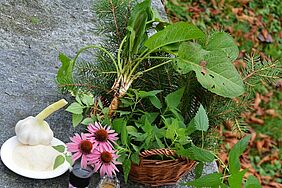Species-rich Alpine meadows are for cows what modern shopping centres are for people: a fragrant supermarket including a tobacco section and a chemist. Cows find an equally large diversity of scents, tastes, and toxic as well as useful active substances in such grasslands. Farmers have long been familiar with many of the effects of herbs, fruit, roots and tree barks, and they use these to treat themselves as well as their animals. For a number of years now, FiBL veterinarian Michael Walkenhorst and his students of pharmacology have been collecting and categorising this type of traditional knowledge as part of their "ethno-veterinarian" research and have been publishing their findings in scientific journals. Traditional knowledge is to be preserved for posterity and shall serve veterinary medicine as a knowledge base on medicinal plants.
Long-term study shows: Active substances contained in herbs improve health
At FiBL, we are also investigating the veterinary potential of the active plant compounds in experimental trials. In 2020 we were able to publish an important long-term study on the health effects of herb-rich supplementary feeds for dairy cows. Above all, the study showed a clear positive effect on udder health: Cases of increased cell counts fell by more than 20 per cent. In a further study, herbal extracts proved to be suitable for stabilising dairy cows in critical metabolic situations. Another important aspect are anti-parasitic effects. Tannins, which are contained for example in the fodder legume sainfoin, can inhibit gastrointestinal parasites in sheep and goats, among other effects. FiBL researchers Veronika Maurer, Felix Heckendorn and Steffen Werne have been working on this topic for many years now. Over the last two years, this research has been extended to include heather species as part of the RELACS EU project. Under the leadership of Hannah Ayrle, we are also experimenting with herbs such as coriander, garlic and peppermint for poultry in order to test their health-promoting effects.
Variety of tastes also essential for animal welfare
It doesn't always take scientists to find out what helps and what could do damage: In many cases the animals know by themselves. Especially in the case of sheep and cattle, it has been shown many times that they are able to control their metabolism by specifically consuming plants rich in active substances – or by avoiding them – and thus keep bacterial fermentation under control in their rumen and other compartments of their stomachs. These findings have led to the conclusion that this is based on a pronounced ability to differentiate tastes and scents, i.e. that cows are basically gourmets and also that they have deeply rooted needs in this regard. We are dealing with this topic of relevance to animal welfare in several of our research projects on diversity in feeding regimes. In 2020, we set up a "pasture laboratory" at FiBL, where in the future, in cooperation with the Gut Rheinau farm estate, selective grazing by cows on species-rich pastures will be investigated in order to derive feeding recommendations.
More sustainable animal husbandry with herbs?
The secondary plant compounds also have positive effects in terms of sustainability. In certain cases they can, for example, improve the protein metabolism of dairy cows and thus reduce emissions. Alexandra Kapp’s dissertation, which was jointly supervised by FiBL and the Swiss Federal Institute of Technology ETH Zurich, was able to show this effect for the salad burnet in particular. This herb, a member of the Rosacea family, reduced nitrogen losses via the cows' urine by up to 30 per cent. We will therefore continue to include this plant in our research and investigate its suitability for cultivation, among other aspects. Research must also always be prepared to acknowledge if a hypothesis has been shown to be false. For example, we were unable to prove a positive effect of sainfoin on the protein metabolism of either goats or dairy cows. We also do not keep such results to ourselves, but publish them. Secondary plant compounds continue to be an extremely important topic at FiBL’s Department of Animal Sciences. They are a link that extends from botanical biodiversity to animal health and welfare and to sustainability; they are therefore an excellent example of the One Health principle: health must be viewed holistically.
Further information
Contact
Link
fibl.org: Activity report





